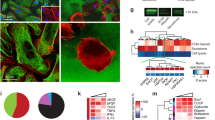Abstract
Gene therapy represents a possible alternative to the chronic delivery of recombinant antiangiogenic proteins to cancer patients. We have constructed retroviral and adenoviral vectors that express murine N-terminal fragments of thrombospondin-2 (NfTSP2), a potent endogenous inhibitor of tumor growth and angiogenesis. To test the possibility of anticancer gene therapy using NfTSP2, we tested whether an ex vivo retrovirus-mediated procedure could be used for the treatment of tumors. The treatment of tumor-bearing mice with syngenic immortalized cell lines expressing NfTSP2 led to a tumor volume reduction up to 70% as compared with the controls (P<0.005). In addition, the established tumors were eradicated in 40% of the mice treated with NfTSP2-expressing cells. Furthermore, the intratumoral injection of the NfTSP2-expressing adenoviral vector to the human squamous cell carcinoma in nude mice resulted in a significant reduction of the growth rates and the volumes of the carcinoma (P<0.05). Immunohistochemical staining of the tumors indicated that the total area and the average size of tumor vessels were significantly reduced in the treatment group versus the controls (P<0.05). In conclusion, the present study clearly demonstrates that the viral vector-mediated transfer of the NfTSP2 gene could inhibit the growth of tumors by perturbing tumor-associated angiogenesis.
This is a preview of subscription content, access via your institution
Access options
Subscribe to this journal
Receive 12 print issues and online access
$259.00 per year
only $21.58 per issue
Buy this article
- Purchase on Springer Link
- Instant access to full article PDF
Prices may be subject to local taxes which are calculated during checkout







Similar content being viewed by others
References
Hanahan D, Folkman J . Patterns and emerging mechanisms of the angiogenic switch during tumorigenesis. Cell 1996; 86: 353–364.
Folkman J, D'Amore PA . Blood vessel formation: what is its molecular basis? Cell 1996; 87: 1153–1155.
Folkman J . Seminars in medicine of the Beth Israel Hospital, Boston. Clinical applications of research on angiogenesis. N Engl J Med 1995; 333: 1757–1763.
Volpert OV et al. Inhibition of angiogenesis by thrombospondin-2. Biochem Biophys Res Commun 1995; 217: 326–332.
Hawighorst T et al. Thrombospondin-2 plays a protective role in multistep carcinogenesis: a novel host anti-tumor defense mechanism. EMBO J 2001; 20: 2631–2640.
Streit M et al. Thrombospondin-2: a potent endogenous inhibitor of tumor growth and angiogenesis. Proc Natl Acad Sci USA 1999; 96: 14888–14893.
Streit M et al. Systemic inhibition of tumor growth and angiogenesis by thrombospondin-2 using cell-based antiangiogenic gene therapy. Cancer Res 2002; 62: 2004–2012.
Bornstein P et al. Thrombospondin 2, a matricellular protein with diverse functions. Matrix Biol 2000; 19: 557–568.
Lawler J . The functions of thrombospondin-1 and-2. Curr Opin Cell Biol 2000; 12: 634–640.
Miyake S et al. Efficient generation of recombinant adenoviruses using adenovirus DNA–terminal protein complex and a cosmid bearing the full-length virus genome. Proc Natl Acad Sci USA 1996; 93: 1320–1324.
Adams JC, Tucker RP . The thrombospondin type 1 repeat (TSR) superfamily: diverse proteins with related roles in neuronal development. Dev Dyn 2000; 218: 280–299.
Good DJ et al. A tumor suppressor-dependent inhibitor of angiogenesis is immunologically and functionally indistinguishable from a fragment of thrombospondin. Proc Natl Acad Sci USA 1990; 87: 6624–6628.
Qabar AN, Bullock J, Matej L, Polverini P . Expression and characterization of novel thrombospondin 1 type I repeat fusion proteins. Biochem J 2000; 346 Pt 1: 147–153.
Hagedorn M, Bikfalvi A . Target molecules for anti-angiogenic therapy: from basic research to clinical trials. Crit Rev Oncol Hematol 2000; 34: 89–110.
O'Reilly MS, Holmgren L, Chen C, Folkman J . Angiostatin induces and sustains dormancy of human primary tumors in mice. Nat Med 1996; 2: 689–692.
Feldman AL, Libutti SK . Progress in antiangiogenic gene therapy of cancer. Cancer Res 2000; 89: 1181–1194.
Griscelli F et al. Angiostatin gene transfer: inhibition of tumor growth in vivo by blockage of endothelial cell proliferation associated with a mitosis arrest. Proc Natl Acad Sci USA 1998; 95: 6367–6372.
Sauter BV et al. Adenovirus-mediated gene transfer of endostatin in vivo results in high level of transgene expression and inhibition of tumor growth and metastases. Proc Natl Acad Sci USA 2000; 97: 4802–4807.
Tanaka T et al. Viral vector-mediated transduction of a modified platelet factor 4 cDNA inhibits angiogenesis and tumor growth. Nat Med 1997; 3: 437–442.
Yu SS, Kim JM, Kim S . High efficiency retroviral vectors that contain no viral coding sequences. Gene Therapy 2000; 7: 797–804.
Nanni P et al. TS/A: a new metastasizing cell line from a BALB/c spontaneous mammary adenocarcinoma. Clin Exp Metast 1983; 1: 373–380.
Yu SS, Kim JM, Kim S . The 17 nucleotides downstream from the env gene stop codon are important for murine leukemia virus packaging. J Virol 2000; 74: 8775–8780.
Kim JM et al. Angiostatin gene transfer as an effective treatment strategy in murine collagen-induced arthritis. Arthritis Rheum 2002; 46: 793–801.
Martell M et al. High-throughput real-time reverse transcription-PCR quantitation of hepatitis C virus RNA. J Clin Microbiol 1999; 37: 327–332.
Streit M et al. Overexpression of thrombospondin-1 decreases angiogenesis and inhibits the growth of human cutaneous squamous cell carcinomas. Am J Pathol 1999; 155: 441–452.
Regulier E et al. Adenovirus-mediated delivery of antiangiogenic genes as an antitumor approach. Cancer Gene Ther 2001; 8: 45–54.
Acknowledgements
This work was supported by grants from the Korean Ministry of Health and Welfare (Grant No. 02-PJ1-PG11-VN01-SV01-0031).
Author information
Authors and Affiliations
Rights and permissions
About this article
Cite this article
Hahn, W., Ho, SH., Jeong, JG. et al. Viral vector-mediated transduction of a modified thrombospondin-2 cDNA inhibits tumor growth and angiogenesis. Gene Ther 11, 739–745 (2004). https://doi.org/10.1038/sj.gt.3302219
Received:
Accepted:
Published:
Issue Date:
DOI: https://doi.org/10.1038/sj.gt.3302219
Keywords
This article is cited by
-
Disease specific urinary biomarkers in the central nervous system
Scientific Reports (2023)
-
Thrombospondins function as regulators of angiogenesis
Journal of Cell Communication and Signaling (2009)



